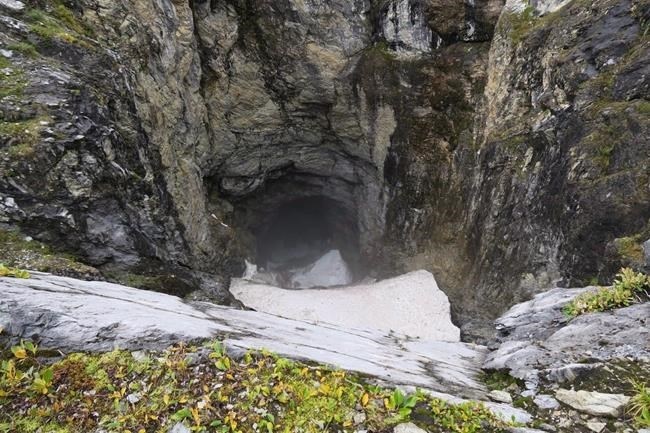
A newly discovered cave in a remote valley in British Columbia's Wells Gray Provincial Park is seen in an undated handout photo. The newly discovered cave and the surrounding area in British Columbia's Wells Gray Provincial Park has been closed off to the public, with threats of fines up to $1 million for those who don't stay away, says an order from BC Parks.
Image Credit: THE CANADIAN PRESS/HO-Tuya Terra Geo Corp., Catherine Hickson
December 20, 2018 - 10:03 AM
VANCOUVER - A newly discovered cave and the surrounding area in British Columbia's Wells Gray Provincial Park has been closed off to the public, with threats of fines up to $1 million for those who don't stay away, says an order from BC Parks.
The order issued this week says anyone who enters the surrounding area or the cave can be fined and face imprisonment for up to a year.
A person can be charged up to $1-million a day for every day that they break the order, it says.
"Until risks to public safety have been assessed and engagement with First Nations has been concluded, the newly discovered cave and surrounding area is closed to public access as per the director's order," it says.
Geologist Catherine Hickson, who first went to the cave in September, welcomed the order.
"I think it's prudent on the part of (BC) Parks to do that," she said. "It is a very dangerous and treacherous area and to reiterate, we went in with a permit."
It's very unlikely that someone would try to get into the cave or the area around it, Hickson said.
"But you know there's a lot of crazies in this world. I wouldn't put it past somebody to try and get into the area," she added.
The entrance pit to the cave is about 100 metres long and 60 metres wide, and while its depth is hard to measure because of the mist from a waterfall, initial examinations show it is at least 135 metres deep.
The cave was initially spotted in March by a helicopter crew with the Ministry of Environment that was conducting a caribou census in the northeastern part of the park.
Hickson said the cave is a one-hour helicopter flight from Clearwater, 480 kilometres northeast of Vancouver.
In the winter, the cave can be accessed by skiing about 100 kilometres from the entrance to the park, while during the summer it would require a 45-kilometre boat trip and another 15-kilometre walk.
"It's not an easy cave to get to," she said.
The cave is a vertical climb down with lots of water and ice, she said.
"People may try to enter the cave and that is risky unless you are well trained and well equipped," Hickson said. "This isn't a climb you can do on a whim."
If someone gets into trouble, another person would have to risk their life to help them, she said.
The cave is the largest known of its type, a variety of "striped karst," which is marble interspersed with other types of ancient ocean rock.
Those who first spotted the cave from the helicopter named it Sarlacc's Pit because of its similarity to the lair of Sarlacc, a creature from "Star Wars: Return of the Jedi."
Caves support a very unique ecosystem because they are dark so the flora and fauna living in such areas are acclimatized to those conditions, Hickson said and that is one of the other reasons that Parks BC is trying to protect the site.
"It's to help with safety of the people and the cave."
News from © The Canadian Press, 2018